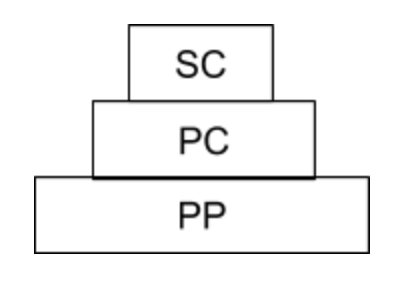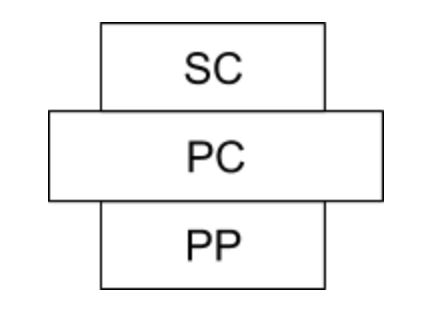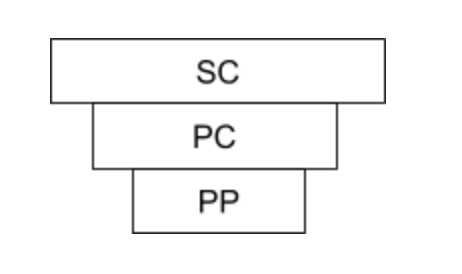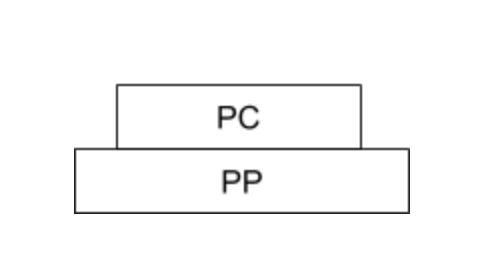
Which of the given pyramids represents the variation in biomass at different trophic levels in the pond ecosystem?
A
A.

B.

C.

D.





Answer
474.9k+ views
Hint: Biomass is calculated as the mass of living organisms present at each of the trophic levels in a given sample size at the time. It can also be represented as dry weight in grams or calories per unit area. To measure biomass a bomb calorimeter is used.
Complete answer:
A biomass pyramid is the diagrammatic representation of the total living biomass or the organic matter present at the different trophic levels in an ecosystem.
Trophic levels are the particular place that a living organism occupies in a food chain.
In a biomass pyramid, producers (also known as first trophic level) are kept at the base, then followed by herbivores (also known as primary consumers) and then the carnivores (which can be both secondary and tertiary consumers) are kept at the top.
The pyramid of biomass also represents the flow of energy from the producers to the consumers. As we know, only Ten per cent of the energy is transferred to the next trophic level while the rest of energy is either utilised for metabolic processes or excreted out.
In a pond ecosystem, the standing crop of phytoplankton are the primary producers and the major producers, at any given point will be lower than the mass of the heterotrophs i.e. secondary or primary consumers, such as fish and insects. Hence the pyramid of biomass becomes inverted in the pond ecosystem'.
Hence, the correct answer is option (C).
Note: Biomass pyramids represents how much biomass (i.e. the amount of living or organic matter present in an organism) is present in the organisms at each of the trophic level, while productivity pyramids represents the procreation or turnover in biomass.
Complete answer:
A biomass pyramid is the diagrammatic representation of the total living biomass or the organic matter present at the different trophic levels in an ecosystem.
Trophic levels are the particular place that a living organism occupies in a food chain.
In a biomass pyramid, producers (also known as first trophic level) are kept at the base, then followed by herbivores (also known as primary consumers) and then the carnivores (which can be both secondary and tertiary consumers) are kept at the top.
The pyramid of biomass also represents the flow of energy from the producers to the consumers. As we know, only Ten per cent of the energy is transferred to the next trophic level while the rest of energy is either utilised for metabolic processes or excreted out.
In a pond ecosystem, the standing crop of phytoplankton are the primary producers and the major producers, at any given point will be lower than the mass of the heterotrophs i.e. secondary or primary consumers, such as fish and insects. Hence the pyramid of biomass becomes inverted in the pond ecosystem'.
Hence, the correct answer is option (C).
Note: Biomass pyramids represents how much biomass (i.e. the amount of living or organic matter present in an organism) is present in the organisms at each of the trophic level, while productivity pyramids represents the procreation or turnover in biomass.
Latest Vedantu courses for you
Grade 10 | CBSE | SCHOOL | English
Vedantu 10 CBSE Pro Course - (2025-26)
School Full course for CBSE students
₹37,300 per year
Recently Updated Pages
Master Class 9 General Knowledge: Engaging Questions & Answers for Success

Master Class 9 English: Engaging Questions & Answers for Success

Master Class 9 Science: Engaging Questions & Answers for Success

Master Class 9 Social Science: Engaging Questions & Answers for Success

Master Class 9 Maths: Engaging Questions & Answers for Success

Class 9 Question and Answer - Your Ultimate Solutions Guide

Trending doubts
Draw ray diagrams each showing i myopic eye and ii class 12 physics CBSE

Why do the transition elements have higher enthalpies class 12 chemistry CBSE

What are the advantages of parallel combination over class 12 physics CBSE

What are the causes of overloading class 12 physics CBSE

How do you convert from joules to electron volts class 12 physics CBSE

There is hypertension due to smoking Give scientific class 12 biology CBSE




